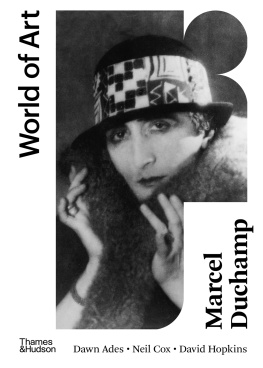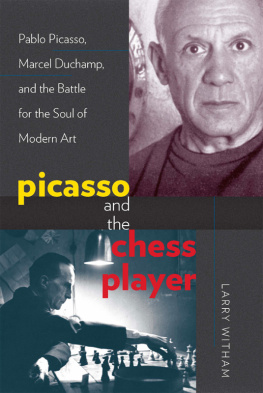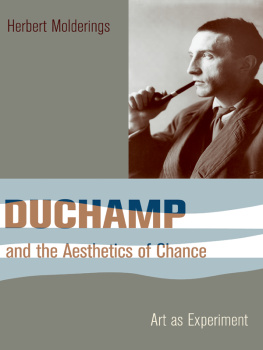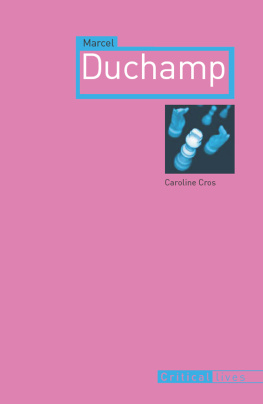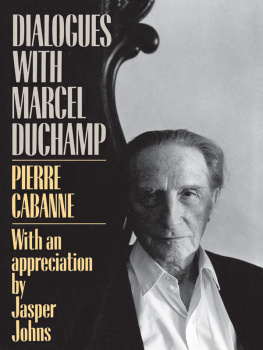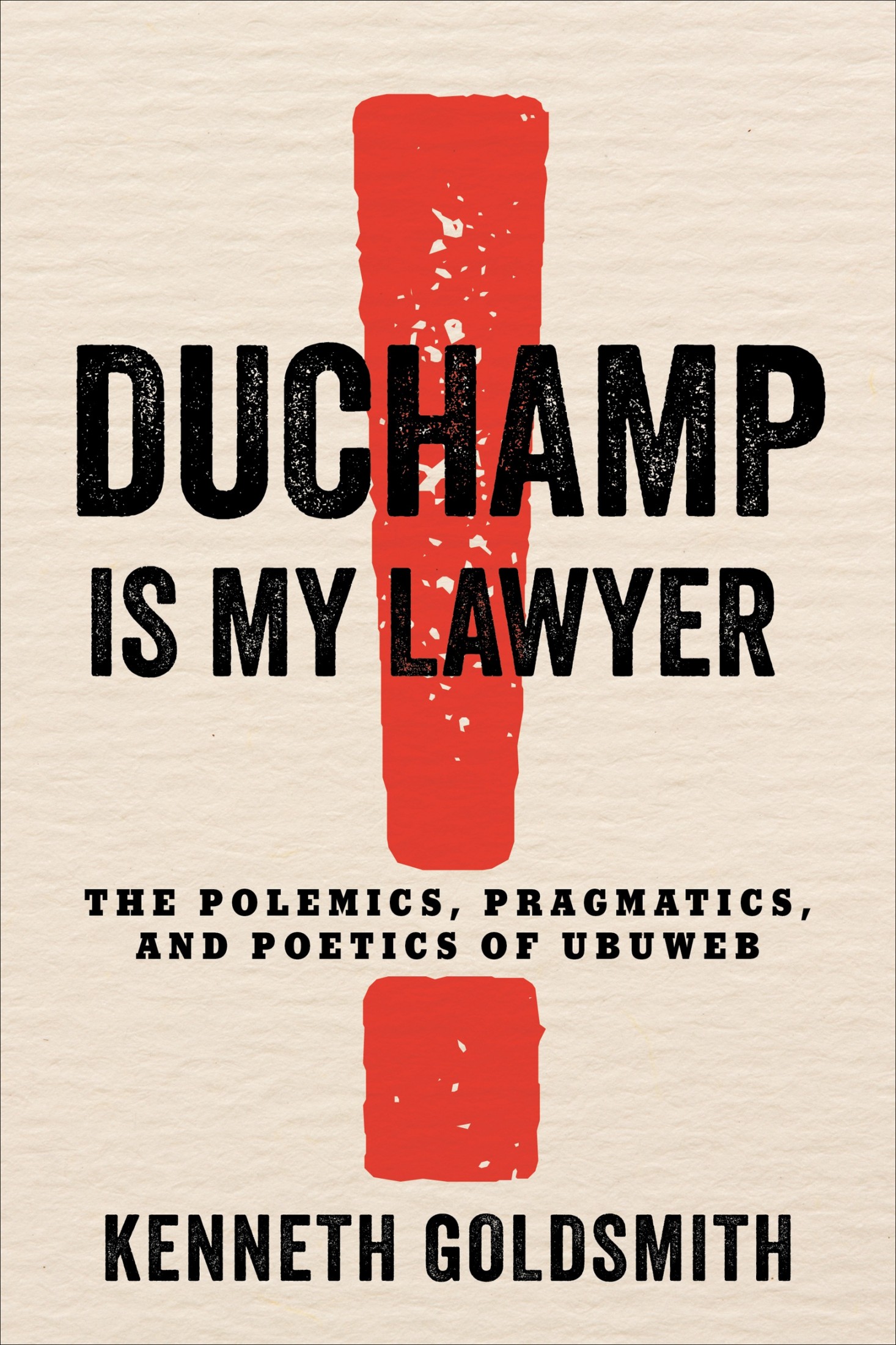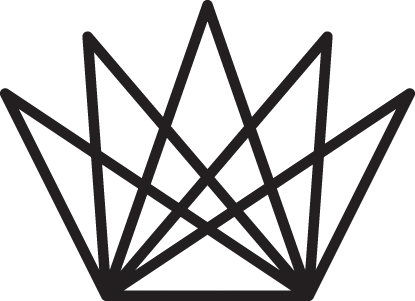
Columbia University Press
Publishers Since 1893
New York Chichester, West Sussex
cup.columbia.edu
Copyright 2020 Columbia University Press
All rights reserved
E-ISBN 978-0-231-54691-1
Library of Congress Cataloging-in-Publication Data
Names: Goldsmith, Kenneth, author.
Title: Duchamp is my lawyer : the polemics, pragmatics, and poetics of UbuWeb / Kenneth Goldsmith.
Description: New York : Columbia University Press, [2020] | Includes bibliographical references and index.
Identifiers: LCCN 2019058881 (print) | LCCN 2019058882 (ebook) | ISBN 9780231186940 (hardcover) | ISBN 9780231186957 (paperback)
Subjects: LCSH: UbuWeb. | ArtsExperimental methodsComputer network resources.
Classification: LCC NX260 .G65 2020 (print) | LCC NX260 (ebook) | DDC 700.285dc23
LC record available at https://lccn.loc.gov/2019058881
LC ebook record available at https://lccn.loc.gov/2019058882
A Columbia University Press E-book.
CUP would be pleased to hear about your reading experience with this e-book at .
Cover design: Lisa Hamm
I often tell people that Duchamp is my lawyer. Hes the legal premise to validate what Im doing.
Virgil Abloh
For the Custodians

T heres a back door to the Museum of Modern Art (MoMA) in New York City that few know about. Invisible to the bustling crowds at the main entrance on Fifty-Third Street, its desolate except for the occasional noisy school group or quiet academic researcher entering and exiting. Therere no admission fees or snaking queues, only a lonely intern sitting at a desk. If you sign in and take the elevator to the top floor, youll find the MoMA Library. It was there in the late 1970s that a librarian named Clive Phillpot created a policy unlike any other in the history of the museum. Without asking permission, he decreed that anybody could mail anything to the MoMA Library, and it would be accepted and become part of the official collection. There was no limit to what could be sent, nor were there specifications of size, medium, or provenance. No judgments were made about quality either. The artist could be world famous or completely unknownit made no difference. Once something was sent, no questions were ever asked. Whatever was received was accepted.
Phillpot estimates that between 1977 and 1994 he got anywhere from 100,000 to 200,000 artists into the MoMA collection this way. Similarly, Phillpots gesture was so under the radar that the front doorthe museum administration and curatorial wingpaid no attention to it. And once they did, it was too late; nobody was going to return all those crates and boxes that had piled up over the years, never mind remove hundreds of thousands of artists from the database. While some artifacts from those acquisitions are quite valuable and are often on display in the galleries, most of them languish in MoMAs remote storage facility out in Queens, stacked up in the boxes they were originally sent in. And theyre all still part of MoMAs collection.
Sometimes the back door was used to get artworks into the museum. In 1991, Chuck Close was asked to curate an Artists Choice exhibition. Close decided to choose a selection of portraits from MoMAs collection, and he wanted to include Ray Johnson, who at the time wasunbelievably enoughstill not actually in the MoMA collection. So to get himself in, Johnson stuffed a funky photocopied cartoon of Willem de Kooning into an envelope and mailed it off to Phillpot, courtesy of the library. Sure enough, the cartoon was entered into the MoMA collection with the credit line Gift of the artist. The Museum of Modern Art Library, Special Collectionstherefore eligible to be included in Closes show.
The back door is a powerful tool. While all eyes are elsewhere, magical things can happen in the margins. Andy Warhol once said that if you want to collect something in New York, you have to find out what it is that nobody else wants and collect that. Before long, everyone will want it. He was rightonce he began collecting ugly ceramic cookie jars, everyone started collecting them. By the time he died, his cookie jar collection, which he paid pennies for, sold at auction for a quarter of a million dollars. Warhol was a back-door collector. Out of the watchful eye of the front door and free to write its own ticket, the back door plays by its own rules. Unburdened by official policy, it can quietly reshuffle the deck according to intuition, whim, and desire. While the front sparkles with glamour and sexy commodities, the back door favors that which is economically worthless but historically priceless. Trading in ephemera and ideas, the back door is unlocked and unguarded, for its assumed that theres not much worth stealing inside that rear dooroften a correct hunch. Yet because the back door is always open, its ideas are infinitely democratic, transferrable, and replicable as well as free to all. At once playfuleven prankishand deadly serious, the back door is perverse, embracing contradiction and impurity. Its also wildly utopian, proposing to make the impossible possible. What begins as a hunch or proposition over time becomes serious. If you do something wrong for long enough, it eventually becomes rightparadoxically transforming the back door into the new front door.
Marcel Duchamp once made a door hinged between two frames that was always open and always shut. The door closed one entrance when it opened the other, thereby contradicting the French proverb Il faut quune porte soit ouverte ou ferme [A door must be either open or closed]. It is both and neither at the same time. Writing to Andr Breton, Duchamp said, Pour moi il y a autre chose que oui, non et indifferentCest par example labsence dinvestigations de ce genre [For me there is something other than yes, no, and indifferentthere is for example the absence of investigations of this kind]. Open and closed, pirate and legitimate, serious and playful, UbuWeb has attempted to model itself on Phillpots back door and Duchamps pendulous door, resulting in a decades-long investigation into the absence of an investigation.
Founded in 1996, UbuWeb is a pirate shadow library consisting of hundreds of thousands of freely downloadable avant-garde artifacts. By the letter of the law, the site is illegal; we openly violate copyright norms and almost never ask for permission. Most everything on the site is pilfered, ripped, and swiped from other places, then reposted. Weve never been suednever even come close. UbuWeb functions on no moneywe dont take it, we dont pay it, we dont touch it; youll never find an advertisement, a logo, or a donation box. Weve never applied for a grant or accepted a sponsorship; we remain happily unaffiliated, keeping us free and clean, allowing us to do what we want to do, the way we want to do it. Most important, UbuWeb has always been and will always be free and open to all: there are no memberships or passwords required. All labor is volunteered; our server space and bandwidth are donated by a likeminded group of intellectual custodians who believe in free access to knowledge. A gift economy of plentitude with a strong emphasis on global education, UbuWeb is visited daily by tens of thousands of people from every continent. Were on numerous syllabuses, ranging from those for kindergarteners studying pattern poetry to those for postgraduates listening to hours of Jacques Lacans






